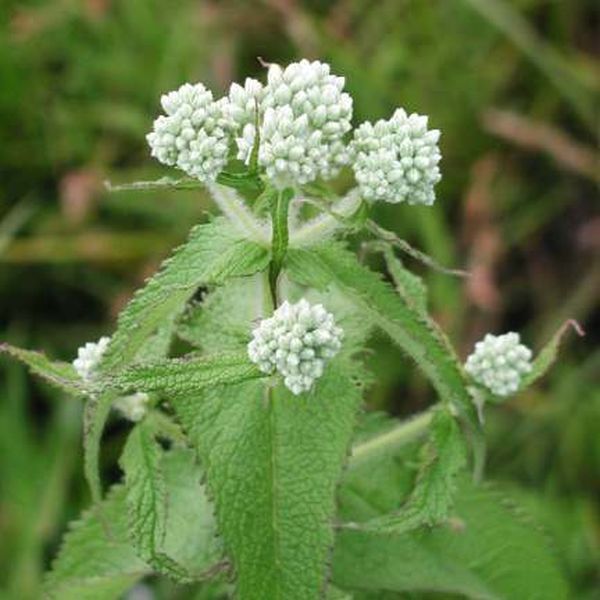Boneset is a member of the Asteraceae, or daisy, family. It is a ubiquitous plant found growing in swamps, marshes, and shores from Canada to Florida and west to Texas and Nebraska. The plant easily is recognized by its long, tapering leaves that join each other around a single stout stem, giving the impression of one long leaf pierced at the center by the stem. Hence its name perfolia, meaning “through the leaves.”
Boneset has been used as a charm and as a medicinal remedy for centuries by indigenous North Americans. As a charm, the root fibers were applied to hunting whistles with the belief that they would increase the whistle’s ability to call deer. As an herbal remedy, American Indians used boneset as an antipyretic (to reduce fevers). The early settlers used the plant to treat rheumatism, dropsy, dengue fever, malaria, pneumonia, and influenza. The name boneset was derived from the plant’s use in the treatment of breakbone fever, a term describing the high fever that often accompanies influenza. Boneset was official in the US Pharmacopeia from 1820 to 1900.
Boneset chiefly has been used to treat fevers. Boneset sometimes is found in herbal combination products for colds, flu, and fevers. There are no clinical studies evaluating its safety or effectiveness in the treatment of these conditions.
There is no recent clinical evidence to guide dosage of boneset. Traditional use was at a dose of 2 g of leaves and flowers. Internal use should be tempered by the occurrence of hepatotoxic pyrrolizidine alkaloids in this plant.
Early research suggests that taking a specific homeopathic product made from boneset reduces symptoms of the common cold similarly to aspirin.
The ingestion of large amounts of teas or extracts may result in severe diarrhea. The identification of pyrrolizidine alkaloids in related Eupatorium species is cause for concern until detailed phytochemical investigations are carried out on boneset. This class of alkaloids is known to cause hepatic (liver) impairment after long-term ingestion. While direct evidence for a hepatotoxic effect from boneset does not exist, there is sufficient evidence to indicate that any plant containing unsaturated pyrrolizidine alkaloids should not be ingested.
The appropriate dose of boneset depends on several factors such as the user’s age, health, and several other conditions. At this time there is not enough scientific information to determine an appropriate range of doses for boneset. Keep in mind that natural products are not always necessarily safe and dosages can be important. Be sure to follow relevant directions on product labels and consult your pharmacist or physician or other healthcare professional before using.
Post time: Aug-07-2020
